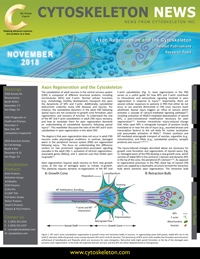November Newsletter: Axon Regeneration and the Cytoskeleton
- By Cytoskeleton Inc. - Tubulin News
- Nov 1, 2018

The cytoskeleton of adult neurons in the central nervous system (CNS) is composed of different structural proteins, including microtubules (MTs) and F-actin. Normal cellular functions (e.g., morphology, motility, development, transport) rely upon the dynamicity of MTs and F-actin. Additionally, cytoskeletal dysfunction underlies many CNS diseases and injuries. For instance, the cytoskeletal dynamics in the adult CNS following axonal injury are not conducive to growth cone formation, axon regeneration, and recovery of function. To understand the role of the MT and F-actin cytoskeleton in adult CNS injury recovery, and how to modulate them for axon regeneration demands an understanding of cytoskeletal dynamics following axonal injury1,2. This newsletter discusses the roles of the MT and F-actin cytoskeleton in axon regeneration in the adult CNS.
The dogma is that axon regeneration does not occur in adult CNS neurons under physiological conditions. In contrast, damaged axons in the peripheral nervous system (PNS) are regenerated following injury. The focus on understanding this difference centers on two prominent regeneration-associated signaling cascades in the adult CNS: 1. activation of intrinsic regeneration-associated genes [RAGs]), and 2. external cues that inhibit axon re-growth1,2.
Also included in this newsletter:
- Tubulin and Actin Live Cell Reagents, G-LISA Activation Assay Kits, Tubulin Kits, Actin Biochem Kits
- Related Publications

